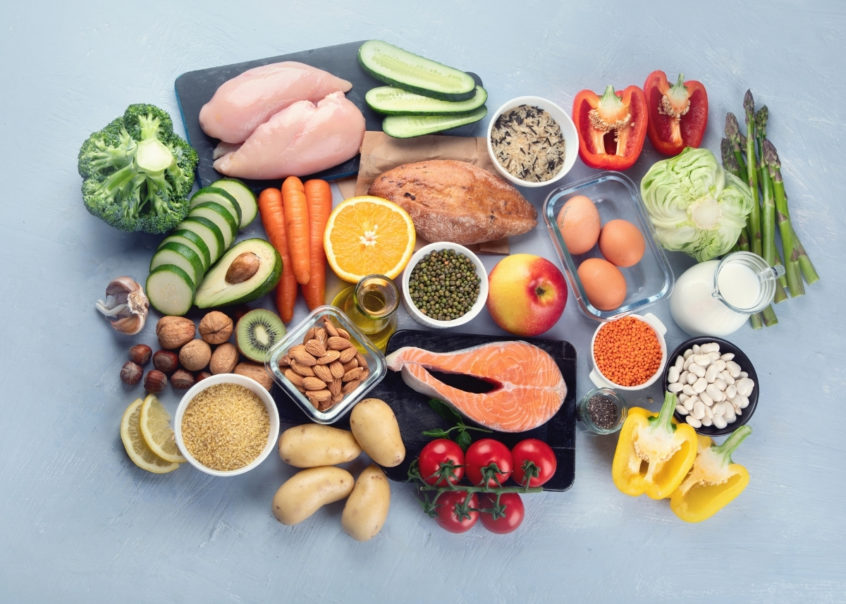Equilibrium
by Circuit

A Certified Dietitian Shares Advice on Fad Diets and Managing a Food Plan That Works
22.09.2021
Circuit is proud to have hosted several events around wellness and nutrition, and one of our favorite virtual events was focused around fad diets and effective strategies for eating well. In this particular virtual event, we welcomed Stephanie May, a Board Certified Sports Dietitian, who specializes in nutrition coaching for high school athletes and active people of all ages. In this event, our residents learned more about popular fad diets, how to recognize the red flags of many of these diets, and most importantly, how to flip the script on these ways of thinking by balancing your plate and staying motivated to optimizing your food plan.
Here are some highlights from this health and wellness inspired virtual event.

The leading fad diets
Some of the most popular trending diets have included the Atkins diet (low carb), gluten-free (which eliminates flour-based grains and wheat), Keto – which is a mode modified version of the Atkins with low carb, as well as intermittent fasting.
Stephanie mentions various objections to the Atkins, Keto, and gluten-free diets, noting that cutting out an entire food group can be risky and over time deprive you of vital sources of nutrients and energy that your body needs. For example, limiting food groups such as breads can deprive you of grains that fuel you with energy, while limiting milk and cheese can deprive you of calcium, so it’s important to be cautious with this and only exercise alternatives if you have a true food allergy.
“With intermittent fasting, if you eat past 7-9pm, that food or calorie automatically is metabolized as fat, but your body doesn’t actually have a switch like that. it’s much more fluid and open. You can eat late, and while its not the best idea, as long as you are within your caloric and nutrient range you will not implicate anything” Stephanie notes. Vital nutrients such as calcium, magnesium, protein and vitamin D can all be compromised with restrictions and food deprivation, which can lead to muscle loss and bone density repercussions down the line. Even more significantly and in the forefront today, malnutrition opens you up to greater susceptibility of illness.
The red flags of diets
Americans spend billions on diet products every year and sadly most don’t last. Yet every year, packaged in a new and different way, celebrity fad diets and weight loss both sell, as seen on the covers of magazines in the checkout aisles and across social media. Comparing yourself to these celebrities is not only unrealistic, but ineffective as everyone is built differently. Trendy taglines such as “lose inches in 14 days, 21 days to a better you, inches will melt off” are all indicators that you probably want to stay away from whatever is being sold to you. Oftentimes with many of these empty promises, people end up regretfully realizing way too late that they have spent too much on branded shakes, supplements, energy bars, and special enhancements that they think are going to help them manage their expectations.
Creating a personalized lifestyle plan that works for you
While it’s important to acknowledge that weight loss is a common goal of dieting, keep in mind that as you lose weight, you first lose water, then muscle, and finally fat, which is the last to leave. It’s so important when you build a “lifestyle” plan (for better word choice than diet), to think of food in 3 buckets. Food is: fuel, emotional and social. It is celebratory, it’s at every social gathering, and it gives you life. Your lifestyle plan should hit all those points.
Other than weight loss, muscle gain, and improved overall health, other are key reasons many people select a lifestyle plan. The easiest and most relatable thing is a plate. It translates much more than thinking of your food in ounces, calories, or macros.
You essentially want to build your plate with a protein, carb, and vegetable, also including a fat in one of those categories which works with protein and carbs as your main sources of energy. The proportion of your protein, carb, and vegetable intake should depend on your current output of physical activity.
While selecting food categories to fit these proportions, it’s also critical to remember that your diet should essentially be energy and nutrient dense. Energy dense foods include things like oysters, peanut butter, lean proteins such as chicken and turkey, beans, and some whole grains such as brown rice or whole grain pasta. Nutrient dense foods include a lot of your fruits and veggies such as spinach, broccoli and other greens. A balance of both nutrient and energy dense foods are also proven to help assisting weight loss.
Additional key things to keep in mind with food groups
- Remember that your key energy sources are carbohydrates, fats, and proteins. Diets stop working when people run out of energy or are still hungry.
- Your colors (vegetables) add antioxidants, fiber, and protect your body overall. They are also lower in calories so you can get a larger volume of food with lower calorie count.
- Fiber is always critical for a balanced diet, and should be incorporated 80% of the time through whole grains, fruits, and vegetables.
- With protein, you only need 20 – 25g, which is considered more than enough for the general population. Optimal choices of protein include beans, nuts, seeds, meats and fish and even some grains such as quinoa. Cheese, yogurt, and milk all have some protein as well as calcium.
- Healthy fats such as salmon, olive oil, avocado, nuts, and seeds not only provide healthy brain supporting Omega 3’s, but are also great options to help you stay full while building healthy brain function and providing energy. 1 gram of fat actually gives you more energy than carbs and proteins. Key vitamins such as Vitamin A, D, E & K all are absorbed by fats, and contain anti-inflammatory properties.
- A key to helping curb your appetite is to be consistent. Give your body steady increments of protein throughout the to help maintain satiety or fullness so you won’t get hungry so often. Aim for at least one small form of protein in each meal/snack wherever possible.
- If you are in a bind and need a snack on-the-go, pick one without a lot of ingredients or too many calories, but do not consistently rely on them in place of meals.
The Role of Hydration
Often times when you’re hungry, you’re actually dehydrated, so don’t confuse thirst for hunger, Stephanie emphasized. Typical fluid recommendations are that you drink half your body weight in ounces, as a minimum. Hydration is also very individualized, so if you live in a much more humid, hot climate for example, you may need extra hydration in warmer months compared to someone in a cooler climate. Other factors such as electrolyte balance, prior fluid intake, age, weight, muscle mass, and level of physical activity will all play a significant variant in the fluids required. Hydration tips to help you stay motivated to consume adequate fluids daily include adding frozen berries for additional flavor, using flavored seltzer water, picking a bright colored container, or using a straw.
Managing cravings and inevitable challenges
The silver lining is, when you eat a wholesome, balanced plan, you have room to include some indulgences along the way! Stephanie shares that the best way to work with expected cravings for less nutrient rich choices is to ‘make it a mindful moment’. Allow yourself a time, a place, and a portion. Eat a brownie for instance at the kitchen table, enjoy it with a friend, then wrap it and put the rest away so that it’s out of sight, out of mind. Putting tempting treats in the freezer can be a good trick to allowing limited portions with these types of temptations. It can also help when you start out to make a list of non-negotiables. You have to figure out how to work those into your day or your week. These can include things like dessert, a glass of wine, a beer, a piece of chocolate, or a late-night snack. Build this portion and this moment into your day or week, and allow yourself to have these mini-indulgences rather than complete restriction. Also, figure out where your weak spots are. If you know that you hate grocery shopping or aren’t a strong cook, see what options you may be able to build into your life such as an affordable meal prep guide to help you each month, or grocery delivery to help you stay on track.
Finally, focus on building your plate around your goals, adjusting the energy density of your meals, and being consistent with your fuel. The small changes will add up slowly over a time. Health is a priority, and will come slow, but small changes will add up in the long run.
To contact Stephanie May, Board Certified Sports Dietitian for advice or personalized nutrition, you can visit her online at smnutritionrd.com. For more information about having events like this at your property, contact us today.


